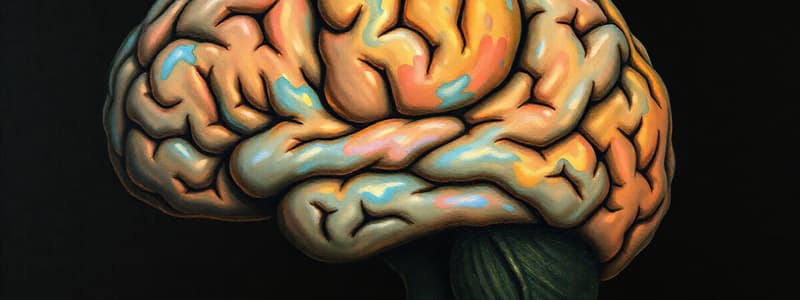Podcast
Questions and Answers
Which of the following regions of the brain is responsible for coordinating voluntary movements?
Which of the following regions of the brain is responsible for coordinating voluntary movements?
- Brain stem
- Diencephalon
- Cerebral hemispheres
- Cerebellum (correct)
The medulla oblongata is part of the diencephalon.
The medulla oblongata is part of the diencephalon.
False (B)
Name one of the functions of the hypothalamus.
Name one of the functions of the hypothalamus.
Regulates body temperature or controls thirst.
The protective layers around the brain are called the ___.
The protective layers around the brain are called the ___.
Match each part of the brain with its primary function:
Match each part of the brain with its primary function:
What is the outer layer of the cerebrum called?
What is the outer layer of the cerebrum called?
The corpus callosum connects the left and right cerebral hemispheres.
The corpus callosum connects the left and right cerebral hemispheres.
What primarily composes the gray matter of the cerebral cortex?
What primarily composes the gray matter of the cerebral cortex?
The inner layer of the cerebrum is known as the ______.
The inner layer of the cerebrum is known as the ______.
Match the parts of the cerebrum with their characteristics:
Match the parts of the cerebrum with their characteristics:
Flashcards
Cerebrum
Cerebrum
The largest part of the brain, responsible for higher-level functions like thinking, learning, memory, and voluntary movement.
Thalamus
Thalamus
The brain's relay station, receiving sensory input and sending it to the appropriate area for processing.
Hypothalamus
Hypothalamus
The brain's control center for regulating body temperature, thirst, hunger, and emotions.
Cerebellum
Cerebellum
Signup and view all the flashcards
Brain Stem
Brain Stem
Signup and view all the flashcards
Cerebral Cortex
Cerebral Cortex
Signup and view all the flashcards
Cerebral Medulla
Cerebral Medulla
Signup and view all the flashcards
Gyri (ridges)
Gyri (ridges)
Signup and view all the flashcards
Sulci (grooves)
Sulci (grooves)
Signup and view all the flashcards
Corpus Callosum
Corpus Callosum
Signup and view all the flashcards
Study Notes
Central Nervous System Overview
- The central nervous system (CNS) is composed of the brain and spinal cord
- The CNS is the control center of the body, responsible for receiving, interpreting, and responding to information from the body and the environment.
Brain Regions
-
Cerebral Hemispheres (Cerebrum):
- Two layers: cortex (outer layer) and medulla (inner layer)
- Paired (left and right), superior parts of the brain
- Make up more than half of the brain mass
- Surface is made of ridges (gyri) and grooves (sulci)
- Contains gray matter (neuron cell bodies), primarily in the cortex
- Contains white matter (myelinated fibers) inside the gray matter, in structures like the corpus callosum which connects the hemispheres
- Lobes include frontal, parietal, temporal, and occipital, named after the bones they sit under
- Specialized areas within the hemispheres control functions like speech, language, memory, sensory perception, and voluntary movement
-
Diencephalon:
- Sits on top of the brain stem
- Enclosed by the cerebral hemispheres
- Made up of the thalamus and hypothalamus
- Thalamus: a relay station that transfers sensory impulses to the correct part of the cortex for localization and interpretation
- Hypothalamus: an important autonomic nervous system center that regulates body temperature, water balance, and metabolism and is part of the limbic system (emotions)
-
Brain Stem:
- Attaches to the spinal cord
- Parts of the brain stem include the midbrain, pons, and medulla oblongata
- Midbrain: mostly composed of tracts of nerve fibers and reflex centers for vision and hearing
- Pons: a bulging center part of the brain stem; primarily composed of fiber tracts, and includes nuclei involved in breathing control
- Medulla Oblongata: the lowest part of the brain stem, important fiber tracts and vital control centers including heart rate, blood pressure, breathing, swallowing, and vomiting
- Reticular Formation: a diffuse mass of gray matter along the brain stem, involved in motor control of visceral organs, and plays a role in awake/sleep cycles and consciousness
-
Cerebellum:
- Two hemispheres with convoluted surfaces
- Coordinates skeletal muscle movement
- Fibres connect to inner ear, eye, and muscle proprioceptors.
Specialized Areas of the Cerebrum
- Primary motor area: sends impulses to skeletal muscles in the frontal lobe
- Somatic sensory area: receives impulses from the body's sensory receptors in the parietal lobe
- Broca's area: in the frontal lobe, involved in the ability to speak (motor)
- Somatosensory association area: involved in recognizing sensory information (identifying what we are touching, feeling, etc)
- Gustatory area: handles taste in parietal lobe
- Auditory area: is in the temporal lobe; responsible for interpreting sound
- Olfactory area: handles the sense of smell, in frontal lobe
- Visual area: in occipital lobe, involved in vision input
- Speech and language interpretation areas: are important areas for complex language processes
Basal Nuclei (Ganglia)
- Internal islands or centers of gray matter that help to control skeletal muscle movements (motor centers)
- Structures include Striatum, Caudate, Putamen, and Globus pallidus
Cranial Nerves
- Cranial nerves are nerves that originate in the brain and emerge from the brainstem
- A list of cranial nerves and their names are shown in one of the images
Studying That Suits You
Use AI to generate personalized quizzes and flashcards to suit your learning preferences.




